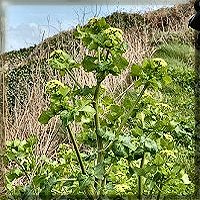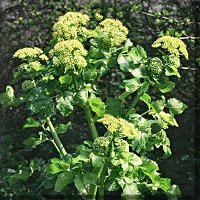

Smyrnium olusatrum


Smyrnium olusatrum
Other Names Black Loveage, Horse Parsley
Edible Parts This biennial is large and resembles celery. They grow from 3 to 5 feet high and their dark stems are topped by glossy, 3-part leaves and bunches of white flowers. The leaves, stems, flowers and seed buds may all be eaten
Edible Uses - Condiment; Flowers; Leaves; Root; Stem. The aromatic leaves which are used either raw or cooked in salads and soups as a substitute for cellery, the fleshy stems can be cooked as vegetables. It is fast growing and easily cultivated in any humusrich, always slightly moist soil in a sunny spot. Will readily self-sow under favorable conditions.
Pharmacology - The roots were used preserved in a sweet-and-sour pickle. The fruit contains an essential oil, cuminal, which is reminiscent of cumin. Smyrnium olusatrum L. is a biennal plant growing in western and southern Europe. Several phytochemical studies have identified flavonoids, phenolic acids and sesquiterpene lactones as main constituents. In this work the root, stem and leaf essential oils of Smyrnium olusatrum L. (Umbelliferae) collected in Urbino (Marche, Italy) were studied by GC and GC-MS. Myrcene (14%), ▀-phellandrene (9%), ▀-caryophyllene (12%), furanodiene (17%), curzerene (12%), germacrene B (10%) and germacrone (8%) were identified as the major components in the root, stem and leaf oils, respectively. SPME analysis of fresh material of the same different organs showed ▀-myrcene (36%), ▀-phellandrene (12%), ▀-caryophyllene (22%) and furanodiene (7%) as typical components in the headspace of fresh roots, stems and leaves, respectively.
Medicinal Uses - The Greek botanist Theophrastus (fourth century BC) made reference to the plant. Dioscorides (first century) also included it in his Materia medica, commenting that its roots and leaves were edible. According to this author, its seed, taken with wine, is an emmenagogue. However, Galen said that it was less active than celery. In the Cˇrdoba of the caliphs, Maimonides also spoke of its powers. During the Middle Ages, it was constantly considered as a plant with diuretic, depurative and aperient properties, particularly through its root. However, its most outstanding quality was perhaps as an antiscorbutic because of its high vitamin C content. The fruit has carminative and stomachic properties. In the eighteenth century, it continued to maintain its reputation as a medicinal
The seeds were often soaked in wine to create a tonic for scurvy when other sources of vitamin C were not available and also to promote menstruation..The root is a diuretic. The crushed leaves or their juice was a soothing and healing treatment for cuts and minor abrasions. It was also used for asthma.
Contra-indications - None indicated!